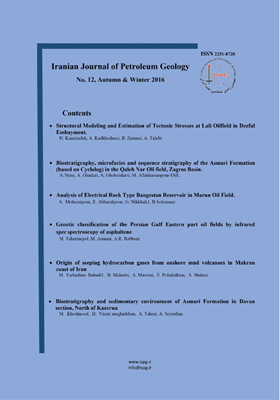طبقه بندی ژنتیکی نفتهای میادین شرق خلیج فارس با استفاده از طیف سنجی مادون قرمز نمونههای آسفالتین
الموضوعات : Geochemistryمرتضی طاهری نژاد 1 , مرتضی آسمانی 2 , احمدرضا ربانی 3
1 - دانشگاه صنعتی امیرکبیر
2 - دانشگاه صنعتی امیرکبیر
3 - دانشگاه صنعتی امیرکبیر
الکلمات المفتاحية: آسفالتین طیف سنجی مادون قرمز تطابق نفت- نفت خلیج فارس ایران,
ملخص المقالة :
آسفالتین موجود در نفت خام همواره به عنوان یک مشکل در صنعت نفت مطرح است، اما آسفالتین ها از ترکیبات مطلوب در مطالعات ژئوشیمیایی خصوصا تطابق نفت- نفت هستند. یکی از موضوعات مهم در مطالعات ژئوشیمیایی، تطابق نفت- نفت می باشد که این امکان را فراهم میآورد که نفت ها از نظر ژنتیکی طبقه بندی شوند. آسفالتین ها بدلیل شباهت ساختاری به کروژن و همچنین عدم تاثیر یا تاثیر کم از فرآیندهای ثانویه به عنوان ترکیبی ارزشمند در مباحث ژئوشیمیایی مطرح میباشند. لذا در این مقاله از ویژگی های ساختاری آسفالتین به عنوان پارامتر تطابق بهره گرفته شد. در این مقاله ویژگیهای ساختاری آسفالتین 5 نمونه نفت از میادین شرقی خلیج فارس با استفاده از روش طیف سنجی مادون قرمز مورد بررسی قرار گرفته است. از نمودارهای دوبعدی و سه بعدی تعریف شده براساس ترکیبات آلیفاتیک و آروماتیک (ترکیبات غالب در ساختار آسفالتین ها) و گروه های سولفوکسید و کربونیل (بیانگر فراوانی عناصر گوگرد و اکسیژن در آسفالتین ها) به منظور مقایسه ساختار آسفالتین ها در نمونه های مختلف مورد استفاده قرار گرفت. براساس نتایج حاصله از نمودارهای تعریف شده، نمونه های نفتی مورد مطالعه دو خانواده با خصوصیات ژنتیکی متفاوت را تشکیل میدهند. خانواده اول شامل نفت میدانهای سلمان و رشادت و خانواده دوم شامل نفت میدانهای رسالت، سیری E و سیری D میباشد. به منظور تایید نتایج حاصل از روش طیف سنجی مادون قرمز، از سایر روش-های متداول ژئوشیمیایی مانند پارامترهای بایومارکری و داده های ایزوتوپ استفاده گردید که این روش ها نتایج بدست آمده را کاملا تایید نمودند. براساس پارامترهای بایومارکری خانواده اول دارای سنگ منشا مارنی بوده و خانواده دوم از سنگ منشا کربناته تولید شده است.
ربانی، ا. (1392)، "زمین شناسی و ژئوشیمی نفت خلیج فارس،" انتشارات دانشگاه تفرش.#
Asemani, M., & Rabbani, A. R. (2016). Oil-oil correlation by FTIR spectroscopy of asphaltene samples. Geosciences Journal, 20(2), 273-283.#
ASTM D 2007 – 03; Standard Test Method for Characteristic Groups in Rubber Extender and Processing Oils and Other Petroleum-Derived Oils by the Clay-Gel Absorption Chromatographic Method, An American National Standard, Reapproved 2008.#
Behar, F., & Pelet, R. (1985). Pyrolysis-gas chromatography applied to organic geochemistry: structural similarities between kerogens and asphaltenes from related rock extracts and oils. Journal of Analytical and Applied Pyrolysis, 8, 173-187.#
Behar, F., Pelet, R., Roucache, J., 1984. Geochemistry of asphaltenes. Organic Geochemistry 6, 587–595.#
Di Primio, R., Horsfield, B., Guzman-Vega, M. A., 2000, Determining the temperature of petroleum formation from the kinetic properties of petroleum asphaltenes. Nature, 406, 173-176.#
IP 143/84, Asphaltene precipitation with n-heptane: Standards for Petroleum and its Products, Institute of Petroleum London, UK, 1984.#
Macko, S. A., Engel, M. H., & Parker, P. L. (1993). Early diagenesis of organic matter in sediments. In Organic geochemistry (pp. 211-224). Springer US.#
Moschopedis, S.E., Parkash, S. and Speight, J.; “Thermal decomposition of asphaltenes”, Fuel, 57, p. p. 431-434, 1979.#
Permanyer, A., Douifi, L., Dupuy, N., Lahcini, A., & Kister, J. (2005). FTIR and SUVF spectroscopy as an alternative method in reservoir studies. Application to Western Mediterranean oils. Fuel, 84(2), 159-168.#
Pelet, R., F. Behar, and J. C. Monin. "Resins and asphaltenes in the generation and migration of petroleum." Organic Geochemistry 10.1-3, p. p. 481-498, 1986.#
Peters, K.E., Walters, C. C., and Moldowan, J. M., 2005, The Biomarker Guide: Biomarkers and Isotopes in Petroleum Systems and Earth History. Second volume, 2th edition, Cambridge University Press, New York, 475- 482.#
Rabbani, A. R., Kotarba, M. J., Baniasad, A. R., Hosseiny, E., & Wieclaw, D. (2014). Geochemical characteristics and genetic types of the crude oils from the Iranian sector of the Persian Gulf. Organic Geochemistry, 70, 29-43.#
Rubinstein, I., C. Spyckerelle, and O. Strausz, Pyrolysis of asphaltenes: a source of geochemical information. Geochimica et Cosmochimica Acta, 1979. 43(1): p. 1-6.#
Semple, K. M., Cyr, N., Fedorak, P. M., & Westlake, D. W. (1990). Characterization of asphaltenes from Cold Lake heavy oil: variations in chemical structure and composition with molecular size. Canadian journal of chemistry, 68(7), 1092-1099.#


